5 min read
Why removing insulation from underfloor heating is costing homeowners
I recently asked our wonderful Customer Experience team what were the typical questions asked byhomeownerswhen they called us. Unsurprisingly, one...
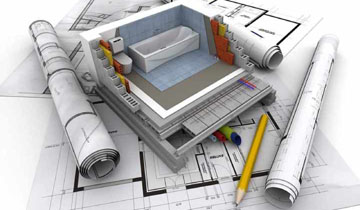
When looking into installing underfloor heating, ‘how thick is underfloor heating?’ ranks in the top three of the most common questions asked. There is good reason for this. If you are a homeowner, the thought of adding more floor height will make you feel somewhat uncomfortable. I mean, who wants to step up into a bathroom? However, technology has come a long way recently, and there is an array of systems available that have minimal impact on floor height.
In this article we’ll break some myths surrounding underfloor heating and floor height, with particular focus on electric underfloor heating. You’ll also be walked through key considerations and options when selecting which electric underfloor system build-up is right for your project.
For the purpose of this article, when we talk about floor height, we will be referring to the build-up required between the substrate (concrete or timber) and the floor finish with adhesive (tiles, wood, carpet etc). A bit like focussing on the sandwich filling rather than the two slices of bread.
No matter what type of underfloor heating system you choose (wet underfloor heating or electric underfloor heating), the heating component of both systems only adds a minimal amount to the total height of the floor. Where floor height is impacted is in the installation process and what component parts are in the floor build-up. For example, the thickness of insulation board or adding a decoupling membrane to help protect tile or stone floor finishes will all impact the total height of the floor.
Wet underfloor heating
Wet underfloor heating systems (sometimes known as water or hydronic underfloor heating) are more commonly used in new build or extension projects because the system can be designed into the design and planning stage before any construction work has started. The pipework is embedded in a thick layer of screed. Typically, the screed layer should not exceed a depth of 65mm but if you are using a flow screed, you can achieve a screed depth of 40mm. The most common pipe diameter is 16mm and a pipe run width of 200mm. The heated part of the system (the pipework) is thicker than its electric counterpart which makes it more challenging to use in retrofit projects.
Electric underfloor heating
Electric underfloor heating systems are thinner than water-based systems and have much less impact on height build-up. The diameter of the heating cable varies between manufacturer and the type of electric underfloor heating system you choose. Where certain systems appear have thinner heating cable an important point to note is the diameter of the cold tail joint. Why? This will impact the floor height as it needs to be buried under the flexible tile adhesive as part of the installation process. So, the thicker the cold tail joint, the more depth of tile adhesive you’ll need which will increase the height of the floor build up. However, there is a way around this. You can dig out a ‘trench’ out of the insulation layer to lay the cold tail joint in, but it is not ideal.
Retrofit projects such as conservatories, bathroom upgrades and wet rooms, are all ideal for electric underfloor heating as it can easily be fitted to the existing sub-floor without the need to dig out more depth.
Best electric underfloor heating build-ups for concrete substrates
We will now walk you through some of the most common floor build-ups for concrete substrates using four different electric underfloor heating systems. Remember that the build-up height will exclude both the substrate (sub-floor) and the floor finish with adhesive.
ThermoSphere Mesh
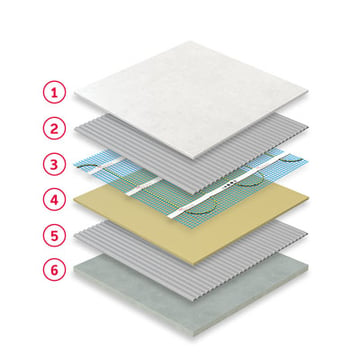
1. Tile 2. Tile adhesive 3. Mesh 4. Uncoated insulation board 5. Tile adhesive 6. Concrete substrate. Height: 17mm (Excluding the substrate, layer 1 and 2).
ThermoSphere Membrane
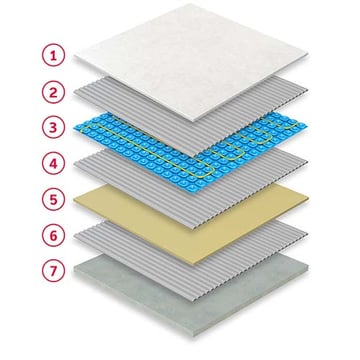
1. Tile 2. Tile adhesive 3. Membrane 4. Tile adhesive 5. Uncoated insulation board 6. Tile adhesive 7. Concrete substrate. Height: 21mm (Excluding the substrate, layer 1 and 2).
ThermoSphere Foil
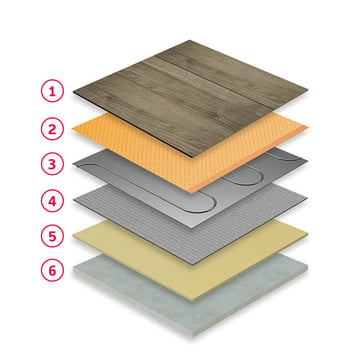
1. Engineered timber 2. Cushioning overlay 3. Foil 4. Cushioning underlay 5. Uncoated insulation board 6. Concrete substrate. Height: 20.5mm (Excluding the substrate and layer 1).
Screed cable
1. Tile 2. Tile adhesive 3. Flow screed 4. Screed cable 5. Foil faced insulation 6. Concrete substrate. Height: 100mm - 150mm depending on the flow screed and insulation layers (Excluding the substrate, layer 1 and 2).
Best electric underfloor heating build-ups for timber substrates
We will now walk you through some of the most common floor build-ups for timber substrates using three different electric underfloor heating systems. Just like the examples above, remember that the build-up height will exclude both the substrate (sub-floor) and the floor finish with adhesive.
ThermoSphere Mesh
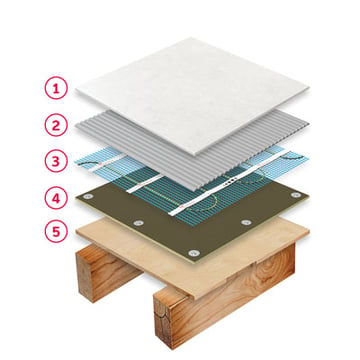
1. Tile 2. Tile adhesive 3. Mesh 4. Coated insulation board 5. Timber substrate. Height: 14mm (Excluding the substrate, layer 1 and 2).
ThermoSphere Membrane
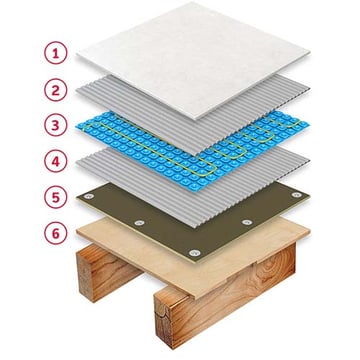
1. Tile 2. Tile adhesive 3. Membrane 4. Tile adhesive 5. Coated insulation board 6. Timber substrate. Height: 19mm (Excluding the substrate, layer 1 and 2).
ThermoSphere Foil
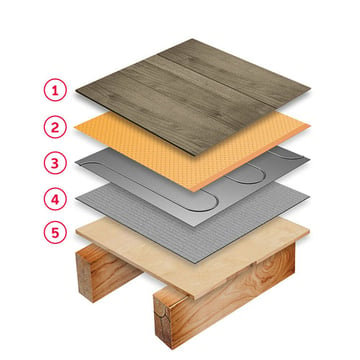
1. Engineered timber 2. Cushioning overlay 3. Foil 4. Cushioning underlay 5. Timber substrate. Height: 10mm (Excluding the substrate and layer 1).
Removing insulation board from the floor build-up is a false economy. Yes, you will reduce the height of the total floor build-up, however it will be to the detriment of the homeowner.
Here’s why.
Let’s take an example of a beautifully tiled floor. You have the substrate below the heating cable and flexible tile adhesive with beautiful tiles above. When you install underfloor heating without insulation board, the heating cable will warm both the layer below and the layer above at the same rate. This means it will take twice as long for the floor to heat up to the required temperature, because you will be losing heat energy downwards. As it is taking longer to reach the desired temperature, the electric underfloor heating system will cost much more to run.
If you include insulation board in the floor build-up, you’ll significantly reduce heat being lost downwards towards the substrate. Instead, most of the heat will be heating the floor above which means that you’ll have the system on for less time to reach optimum temperature and that saves money on the overall running costs. By installing insulation board can improve the efficiency of an electric underfloor heating system by 50% or more.
There are other benefits to including insulation board too:
When quoting insulation board, we usually recommend an insulation board with a minimum thickness of around 10mm. This also tends to be the industry average.
There are two types of insulation board consider; uncoated and coated.
Uncoated insulation boards
This type of insulation board provides a cost-effective thermal insulation for concrete and screed substrates. They are manufactured from a high-density extruded polystyrene and can be installed using a flexible cement-based tile adhesive.
Coated insulation boards
Coated boards are manufactured from a high-density extruded polystyrene core with a fibreglass reinforced cement coating on both sides which adds rigidity, strength and are ideal for a timber substrate. These boards are water resistant and rot proof which makes them a great choice for wet environments such as bathrooms and wet rooms.
Hopefully this article has answered the question ‘How thick is underfloor heating?’ and has provided you with the information you need to give you peace of mind for your electric heating installation. If you have any questions, reach out to our team who are always on hand with helpful advice.
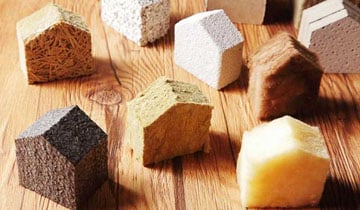
5 min read
I recently asked our wonderful Customer Experience team what were the typical questions asked byhomeownerswhen they called us. Unsurprisingly, one...
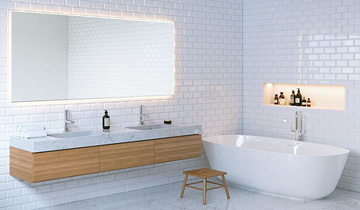
5 min read
This is one of the most commonly asked questions and for good reason! With so many brands of underfloor heating out there including Warm Up, Heat Mat...
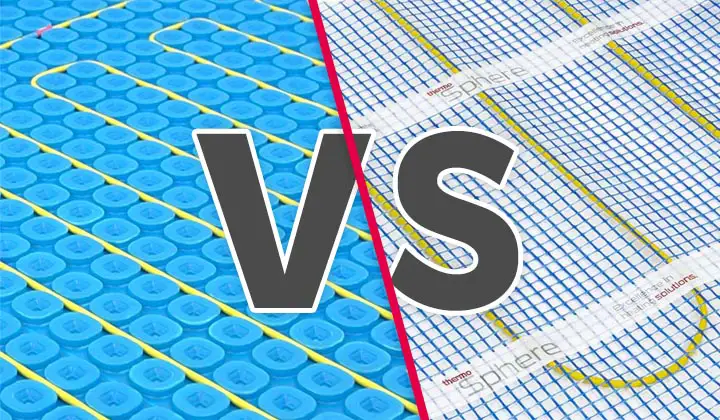
10 min read
When deciding what type of system is best to heat tiled floors, we often get asked why we suggest ThermoSphere Ultimate over ThermoSphere Mesh and...